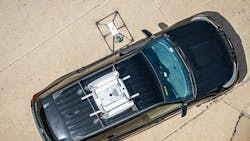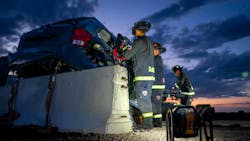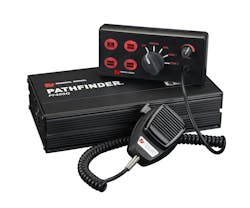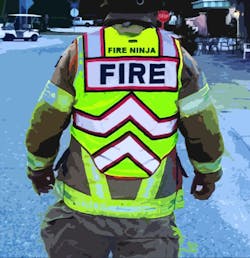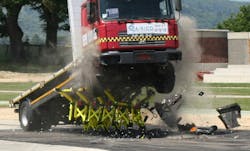8 Innovations to Keep Firefighters Safe at Roadway Incidents
Key Takeaways
- Responder-to-vehicle alerting systems make use of citizen drivers’ connectedness via on-board systems, wearable devices and smartphones to ensure that those people are alerted to the presence of emergency vehicles.
- Unmanned aerial systems that are mounted to the roof of fire apparatus and other official vehicles provide situational awareness to incident commanders to aid in on-scene fire department crew safety.
- Barrier systems that are transported to an emergency scene on a roadway disable a wayward vehicle before it enters the area where firefighters and other first responders are operating.
Responding to a busy road whether for a vehicle collision, medical emergency or vehicle fire adds additional dangers as soon as a responder leaves the security of the station.
According to the Bureau of Labor Statistics, as of the middle of the past decade, one-fifth of annual fatal injuries for firefighters are roadway vehicle accidents.
Luckily, some great innovations help to improve firefighter safety while members are en route and on scene. Eight solutions particularly caught our eye.
R2V alerting
The average driver on roadways is connected in some fashion, whether that be via an on-board system, a wearable device or a smartphone. Responder-to-vehicle (R2V) alerting systems, such as HAAS Alert’s Safety Cloud, make use of that connection to ensure that drivers are made aware of the presence of emergency vehicles in their vicinity.
Whether en route or on scene, the system sends real-time digital alerts to nearby drivers on any number of apps, including Apple Maps and Waze. These alerts provide instructions to drivers, such as “emergency vehicle approaching, pull to the right,” “emergency vehicle ahead” and “emergency vehicle on scene, slow down and move over.”
When the system is installed in an emergency vehicle (or integrated with preexisting telematics systems), it’s activated automatically when the rig’s emergency lights are turned on.
Added situational awareness for other drivers isn’t the only option available. The next option provides enhanced situational awareness for first responders who are on scene.
Overwatch
As unmanned aerial systems (UAS) continue to gain in popularity, on-scene fire department crew safety is another significant use case for drones, particularly those that are tethered and capable of being deployed from the top of a responding apparatus.
FotoKite and others offer roof-mounted UAS that deploy with the touch of a button and don’t require a licensed drone pilot to operate. With color camera and thermal camera capabilities, FotoKite’s Sigma provides a maximum vantage point of 150 feet to give situational awareness to an incident commander, particularly on roadside incidents where a pumper often is used to block traffic. The thermal camera offers visibility at night, and the drone can fly for at least 24 hours. This makes it a powerful addition for all emergency scenes.
If you are looking for something that offers more than just situational awareness, there are options that can alert crews and other drivers alike.
The Alpha Safenet Alpha Overwatch system comes in several configurations and essentially establishes an electronic boundary. When the boundary is crossed, audible and visual alerts are provided to everyone who is in proximity. When used properly, the system can help to alert distracted drivers before they enter the emergency scene. If they course-correct, the system is smart enough to reset the alerts.
Visibility enhancements
For some departments, the aforementioned overwatch options might be a bit too pricey. Here are a few lower-tech systems that incur less of an expense.
The thing that I have seen firefighters who are in standard bunker gear on a roadway scene struggle with most is the traffic safety vest. Standard vests aren’t made to be worn over bunker gear. Further, in my experience, the vests often cover up pockets, radios or gear-mounted tools. They also are notorious for not meeting the breakaway standards for roadside safety vests.
The Fire Ninja Ultrabright six-point breakaway public safety vest is a great option to increase firefighter visibility without the traditional problems that are associated with traffic safety vests. As another potential visibility enhancement, departments might consider wearable personal safety lights. Archangel Device’s Guardian Angel Elite Series offers a variety of mounting options and LED color combinations and provides 360 degrees of visibility at a distance of at least five miles.
Attenuators
Although being seen is great, additional physical safety for first responders on a roadway scene might be even more important. Many departments have produced some creative solutions, including the use of old apparatus as a traffic blocker on particularly dangerous roadways. In the event that the rig does its job, it and a wayward vehicle often sustain considerable damage from impact.
The Scorpion II Blocker from TrafFix Devices comes in two options (truck-mounted and towable) and is designed to withstand nuisance impacts and also is capable of redirecting serious collisions. The system can be installed on any vehicle that weighs at least 15,000 lbs. and provides impressive protection for crews and apparatus. If this device is hit directly, it’s great at absorbing the damage and reducing the risk to the passengers in the wayward vehicle. This option might provide physical security, but it also still places a costly apparatus in the danger zone, making the final option that’s noted below more cost-effective.
Portable/modular barriers
Having watched a video on these barriers, we found that they might be the most aggressive option to protect first responders, having been proven to stop even the largest vehicular threat. Best suited for crowd protection at festivals and events, particularly those that take place on a temporary closed street, these options are made to disable a vehicle before it enters an area and causes injuries.
The MVB 3X modular vehicle barrier system from Mifram Security and distributed in the United States by Advanced Security Technologies comes in a variety of configurations. Weighing just 53 lbs. per unit, it’s certified to stop a 7.5-ton vehicle. Although difficult to transport on a fire apparatus, the system comes with custom trailer options. It might be better suited for scenes that require a significant amount of time to mitigate.
An option that falls in between a blocker and a barrier is Mobile Barriers’ MBT-1. The traffic barrier system saved a firefighter and a police officer in Carrollton, TX.
Although these options might seem a little over the top for most departments, for those that spend a significant amount of time operating on busy highways, the devices could be the difference between a tragedy and a member getting to go home at the end of shift.
Minimizing the threat
Roadway emergencies remain a major threat to first responders’ safety. Whether enhancing situational awareness, providing better visibility or pursuing a physical barrier, there are opportunities to enhance firefighter safety. Deploying several of these options that are noted above exponentially helps to reduce the likelihood of a poor outcome on scenes that have a considerable risk for personnel. Don’t wait until there has been an incident or near miss to make the investment.
Product Spotlight
Battery-Powered Work Light
Command Light’s EOS-RDL (Rapid Deploy Light), which is equipped with as much as 20,000 lumens, is designed to provide lighting where first responders need it most. The compact footprint allows for ample storage options and deployment in areas where tripods could obstruct operations.
COMMANDLIGHT.COM/EOS-RDL-RAPIDDEPLOYLIGHT
Siren/Light Controller
Designed to help to get apparatus to the scene safely, the Pathfinder PF400Q from Federal Signal delivers multitone alerts, including the Q-Siren sound. The system can synchronize warning lights to reduce distractions on scene. With Convergence Network Configuration software, the controller enables plug-and-play light bar integration and customizable programming.
Crash Cushion
TrafFix Devices’ Delta TL-2+ Crash Cushion is a TL-2-rated, nongating, redirective crash cushion that passes testing for the Manual for Assessing Safety Hardware regulation at 50 mph. It’s equipped with the Sentinel Impact Tracker, which provides immediate post-impact alerts and GPS-based location, for rapid response and to greatly reduce the risk of secondary incidents.
About the Author

Jason Moore
Jason Moore is a 23-year veteran of the fire service who began his career with the U.S. Air Force as a fire protection specialist. Moore is involved with the International Association of Fire Chiefs’ Technology Council and is a founding member/associate director of the Indiana University Crisis Technologies Innovation Lab. He delivered presentations on implementing technology, using technology for community risk reduction and best practices to justify funding for innovative programs. Moore was the keynote speaker at FireFusion 2024.
